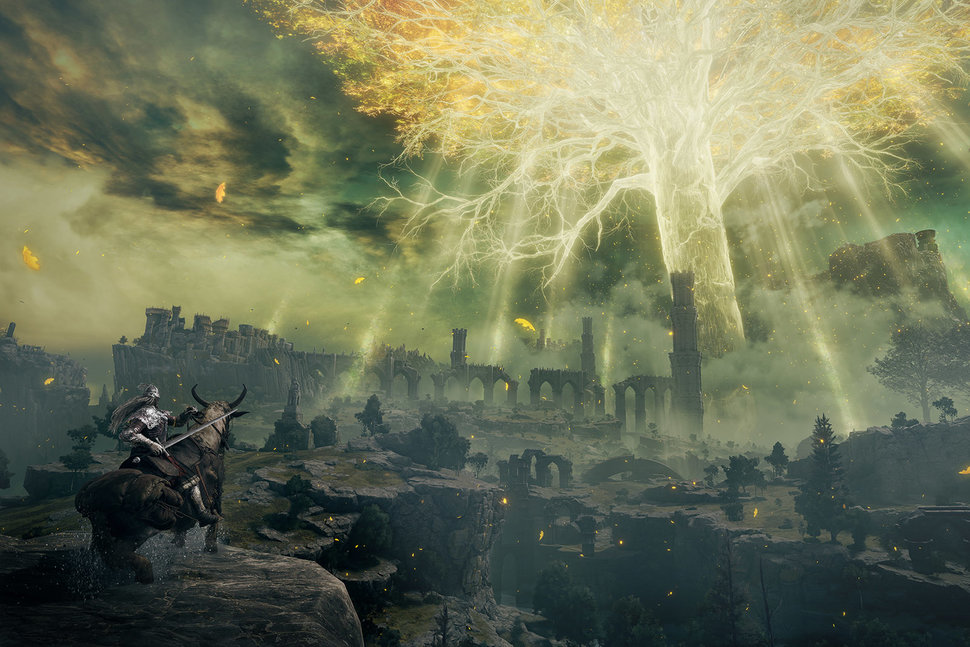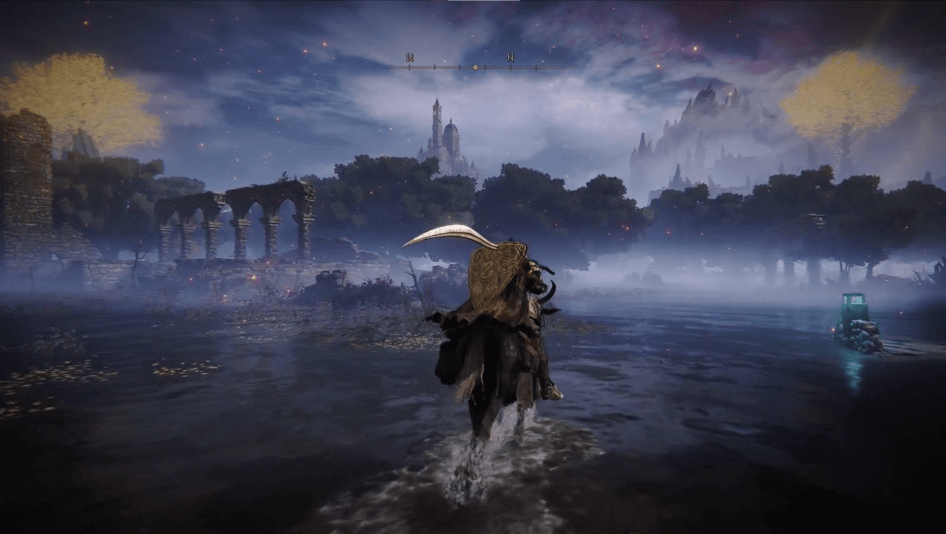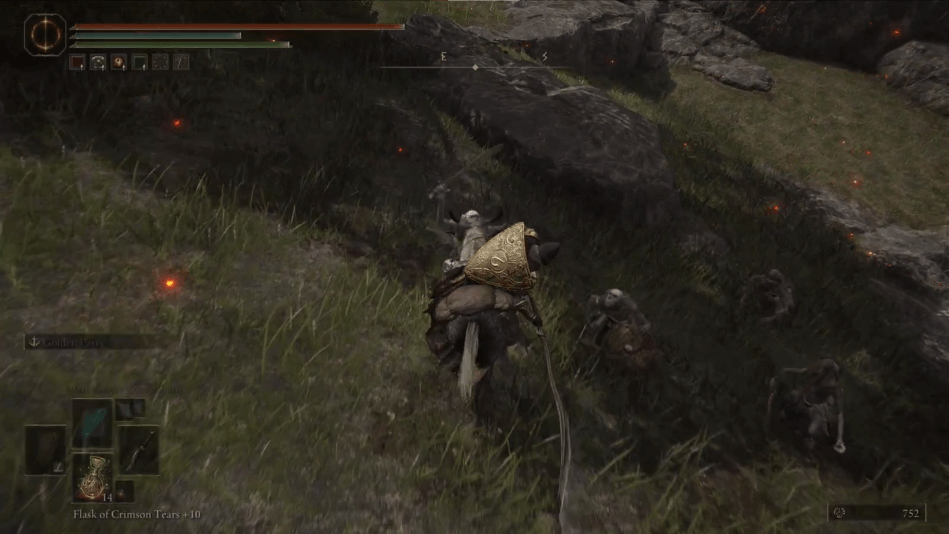Game Reviews
Elden Ring Is a Tour de Force That Comes Once a Generation
FromSoftware enters the open world genre with an explosive entry that sets a new hallmark for game design.

Elden Ring Review
Developer: FromSoftware | Publisher: Bandai Namco | Genre: Action-Roleplaying |
Platforms: Windows, Xbox One, Series X, PS4, PS5 | | Reviewed on: Windows
Within my first thirty minutes of stepping into the George R.R. Martin-inspired world of Elden Ring, I opened up a booby-trapped treasure chest that flung me to—what I thought at the time was—the far corner of the map. I had no horse yet, nor a way to level up, and was surrounded by enemies that could kill me in one hit. Even so, I spent the next hour or so pushing onwards into this area I clearly wasn’t supposed to be in yet, in constant fear of a swift death at any moment.
And I was loving every moment of it.
Elden Ring is the absolute embodiment of a game that seizes your soul in a vice-grip and never lets go. It’s a triumph of the highest degree for both open-world design and the Soulsborne formula that repeatedly left me in awe at the sheer boldness and confidence on display. Relentless, unyielding, and uncompromising in its vision, Elden Ring challenges you to square up to it in whatever way you can, and it felt like a privilege to play because of it.
The land’s one true god has disappeared, the titular Elden Ring has been shattered, and the demi-gods who once governed now war amongst themselves over fragments of the ring left behind. It’s upon this stage that you arrive as a lowly Tarnished tasked with restoring the order that once was in The Lands Between.

Like most FromSoftware games, Elden Ring’s story and lore are purposefully conveyed in vague and obtuse ways, oftentimes through seemingly inconsequential character dialogue and descriptions of items. How much you get out of the story will depend on how much you’re willing to put in to find those details. There are a handful of sidequest lines that are surprisingly forward in describing the state of the world and how it came to be this way, but you’ll still have to keep close attention—and possibly a memo pad—if you want to follow this truly fascinating world on your own. How you experience this story will vary greatly from player to player thanks to Elden Ring’s biggest departure from previous FromSoftware titles, its open world.
The Lands Between are positively sprawling and Elden Ring gives you the freedom to explore wherever you want, whenever you want with minimal exceptions. Each main area is distinct from the rest, ranging from the picturesque grasslands of Limgrave to the hellish poison-infested swamps of Caelid that made my skin crawl every moment I lingered. There are just as many vistas that inspire awe as there are sceneries with a distinct mystique to inspire curiosity. Small touches like the wind blowing through trees, golden leaves falling from the great Erdtree, and docile wildlife milling about give an odd sense of peace and tranquility between moments of intense panic.
As you explore you’ll come across Sites of Grace dotting the landscape which act as fast-travel points and rest spots; some will shine a soft beam of light in the general direction you should go if you want to progress the main quest. Nothing is stopping you from making an about-face and riding off in the complete opposite direction atop your spectral steed, Torrent, though. Your horned spirit horse takes the stress out of traversing rough terrain with its incredibly useful double jump as well as its ability to utilize air-like spirit springs to leap staggeringly tall heights. All these traversal options mean that if you can see something of interest in the distance, more often than not you can reach it.
Undoubtedly, exploration’s strongest aspect is how seemingly insignificant discoveries often snowball into something far grander.
It’s exactly that sort of organic exploration that Elden Ring encourages, and it’s easily one of the strongest parts of the game. When you first step foot into The Lands Between your map is completely empty, bereft of any icons or waypoints to draw your attention. As you explore you may find map pieces to help fill it in but these provide general topographical data of the region and no more. Instead, you yourself decide what catches your eye and is worth checking out whether it’s a large tree looming in the distance or a castle perched atop a cliff.
Undoubtedly, the exploration’s strongest aspect, however, is just how often seemingly insignificant discoveries snowball into something far grander. An inconspicuous ledge may lead to a teleporter that takes you to a far-off land, or a random NPC found in the middle of nowhere may be the key to accessing an optional super boss. There’s nothing quite like galloping along, minding your own business when suddenly a massive dragon swoops in out of nowhere, intent on making you its next bar-b-que meal.

Elden Ring is purposefully designed so that one player most likely isn’t going to see everything it has in store. While this may be a completionist’s worst nightmare it makes the discoveries you do make all the more enthralling. For those that may not be as intrepid, messages left by other players when playing online sometimes help point out what you would otherwise miss and feel like a guardian angel when they’re not trying to get you to whack the umpteenth “hidden path ahead.” It’s not uncommon to get so distracted by the many peculiarities of the world that you forget what you originally set out to do. I was repeatedly stunned when I thought I had finally explored the whole map, only for it to expand and show even more.
When you do feel like advancing the main quest, Elden Ring’s full-scale dungeons will give you the tight-level design of past FromSoftware titles. In these winding, labyrinthine spaces Torrent is unusable, defeating enemies no longer restores healing charges, and your map is more or less useless, forcing you to rely more on your own power as you navigate their dangers. Dungeons are packed to bursting with things to discover beyond the big bad at the end, and with branching paths aplenty sometimes finding a dead-end is just as welcome a sight as knocking down a ladder for a shortcut.
Whether you’re out in the field or trudging a dungeon you’ll be doing a lot of fighting and a lot of dying… a lot of dying. Death comes swiftly and painfully to the careless, with any one of the varied and eye-catching monstrosities you encounter—from a simple sewer rate to some cosmic horror—being capable of draining your health in a matter of moments.
The core aspects of combat will be familiar to anyone who has played a Soulsborne game before. You have your mix of light and strong attacks making up the bulk of your offensive, shields for blocking and parrying, and various ranged options like spells and bows. A new jump attack and shield guard counter round out your moveset to bring just enough spice to the tried and true formula. Weapons have appropriate weight to them and excellent sound design means you’re feeling every hit both on the giving and receiving end. The resounding “ZONG!” after landing a critical hit is just as satisfying at hour one hundred as it is at hour one.

As you defeat enemies you’ll accumulate runes that can be used to level your character and purchase items, but die and you’ll drop all of them on the spot. Die again before reaching the runes and recovering them, and they’re gone for good. This system is a FromSoftware staple and it works just as well in Elden Ring as it does in earlier games. Losing a fat stack of runes stings, but you eventually come to see death as part of a tough-love learning experience.
As you progress you’ll also find various Spirit Ashes that can be used to summon spectral beings to your aid. These range from a simple pack of wolves all the way up to named NPCs with powerful unique moves that can help immensely in taking the heat off during intense fights. You’ll also find Ashes of War, which are special moves that can be equipped to general weaponry to further customize your loadout.
Mounted combat is another new addition. As you ride across the Lands Between atop Torrent, your attack buttons turn into simple swings and thrusts to either side of your steed. Being able to remain constantly on the move while attacking and using items is an incredible advantage, and makes some field encounters feel much more manageable. This power is balanced by the fact that Torrent has no invincibility frames while dodging, though—unlike your standard dodge roll on the ground—and if you take too much damage while riding you’ll be knocked clean off.

Perhaps one of the most impressive things about Elden Ring’s combat is how every build and every playstyle feels viable. There is an absurd number of different weapons in this game. So many, in fact, that additional sorting options would help immensely in parsing through them in the latter parts when you’ve become a walking arsenal. No matter what stat you choose to invest in, though, there will be a wide assortment of weapons to choose from, and you can’t go wrong with any of them. Slipping through enemy attacks with a dagger feels just as good as shooting ice beams from a greatsword which feels just as good as unleashing a bladestorm from a katana that makes you feel like you’re in an anime. Few weapons feel truly worthless and respeccing your character—once it’s unlocked partway through the game—is relatively simple, allowing you to experiment with different builds when you feel like switching things up or when your current style isn’t quite cutting it.
That’s a feeling you might be getting quite a bit too, as the bosses of Elden Ring are many and vicious. Bosses are easily the main spectacle of the game and constantly push you to the limits of your skill or creativity or both. Walking into a new encounter and then immediately dying within the first twenty seconds is far from the exception, it’s the norm. Despite the inherent brutality, boss fights rarely feel unfair and each death almost always falls on your shoulders. The one exception is when fighting aerial enemies the camera can actively work against you, but fortunately, these instances are few and far between.
It’s through this cycle of death and rebirth that the sheer addictiveness of these encounters reveals itself; as you throw warm body after warm body at them you start to unlock their secrets. That one attack that lingers for a second before actually swinging no longer tricks you into rolling early. The ten-second long combo that once obliterated you now seems to come out in slow motion. You realize what once seemed like an impenetrable defense actually has chinks in its armor to exploit. Every attempt is a learning experience and a respawn point, in the form of Grace or Stake of Marika, will always be nearby to let you try again right away. When you finally land that final blow and some variation of “Enemy Felled” flashes across the screen the thrill is downright euphoric.
If a boss is truly giving you a hard time, though, there’s rarely anything stopping you from going off and doing any of the other ten billion things available and coming back to it later. Or maybe you don’t come back at all because in actuality a very small portion of the bosses in Elden Ring is mandatory. It’s that sort of flexibility that makes Elden Ring one of the most accessible FromSoftware games to date. There’s no shame in coming back absurdly over-leveled and going for a victory lap through the boss’s arena. Or heck, if your spirit summon is strong enough, let it do the heavy lifting. In fact, if you do most of what the game has to offer even its endgame becomes a little too easy and I started imposing restrictions on myself to keep the challenge alive. That’s less a critique, though, and more a testament to just how much Elden Ring has to offer.

What is a critique, however, is how many of the bosses will repeat throughout the game, sometimes simply changing the elemental affinity or tacking them on to another boss to make a 2v1. For most of the adventure, this isn’t too much of a problem as there is joy to be had in systematically breaking down a foe that once gave you grief—looking at you, Crucible Knights! By the time you find your sixth dragon or fifth Ulcerated Tree Spirit, though, they start to lose their charm, but the shock and awe of the unique boss fights are more than enough to keep things exciting.
The same repetitiveness can also be applied to the game’s mini-dungeons sprinkled throughout the world. While their gimmicks and challenges vary and provide nice injections of focused level design to reward your explorer’s spirit, seeing the same visual elements over and over wears thin towards the end of the game, especially once you start seeing specific rooms repeating.
On the technical side of things, it’s worth noting that I experienced fairly regular frame stuttering on PC, despite numerous patches being issued meant to address it during my 105 hours of playtime and having a top-of-the-line rig. I also experienced more than a few crashes. While these issues never occurred during critical fights that resulted in my death or loss of progress, they were frequent enough to be annoying. FromSoftware is continuing to address performance issues with the PC version with coming patches so hopefully, it will be in a more stable state soon.
Technical issues aside, the accomplishments that Elden Ring makes cannot be understated. Its absolutely gigantic open world manages to remain compelling, mysterious, and mesmerizing throughout the game. Intrinsically motivated exploration is constantly rewarded with extrinsic results that continuously spur you to see what’s over the next hill or around the next corner. That exploration is reinforced by air-tight combat that challenges you to go beyond your A-game again and again while still providing room for players of all types to feel that sense of fulfillment. Some elements repeat more than they perhaps should, but they’re more than drowned out by the brilliance on display in other areas. Elden Ring feels like the project FromSoftware has wanted to make from the very start, and it’s a definitive hallmark in the ongoing history of video games.

-

 Features4 weeks ago
Features4 weeks agoGet Ready: A Top Isekai Anime from the 2020s Is Headed to Hulu!
-

 Features3 weeks ago
Features3 weeks agoSocial Gaming Venues and the Gamification of Leisure – A New Era of Play
-

 Features3 weeks ago
Features3 weeks agoSolo Leveling Snubbed?! You Won’t Believe Who Won First at the 2025 Crunchyroll Anime Awards!
-

 Culture3 weeks ago
Culture3 weeks agoThe Global Language of Football: Building Community Beyond Borders
-

 Technology4 weeks ago
Technology4 weeks agoIs Google Binning Its Google Play Games App?
-

 Technology4 weeks ago
Technology4 weeks agoHow to Download Documents from Scribd
-

 Guides4 weeks ago
Guides4 weeks agoBoosting and WoW Gold: Why Prestige and Efficiency Drive the Modern MMO Player
-

 Features2 weeks ago
Features2 weeks agoFarewell to a Beloved 13-Year-Old Isekai Anime That Brought Us Endless Laughter
-

 Technology2 weeks ago
Technology2 weeks agoGamification and Productivity: What Games Can Teach SaaS Tools
-

 Features1 week ago
Features1 week agoThis Upcoming Romance Anime Might Just Break the Internet; Trailer Just Dropped!
-

 Features3 weeks ago
Features3 weeks agoWait, What?! Tom & Jerry Just Turned Into an Anime and It’s Glorious!
-

 Culture2 weeks ago
Culture2 weeks agoIs the Gaming Industry Killing Gaming Parties?






















